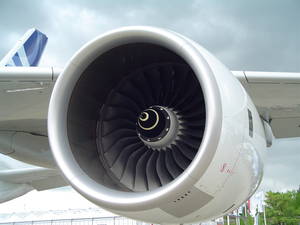New Metals in Jet Engines
Interview with
Ben - In pursuit of better efficiency, jet engine manufacturers like Rolls Royce are constantly searching for materials that will enable their engines to run at higher temperatures, more quietly and give out more power. I met Dave Rugg, Materials Specialist for Rolls Royce under an enormous Trent jet engine to find out what happens once a new material is made.
Dave - The first thing that we have to consider is what we're actually going to use the material for. The key things there really are the load regimes that it's going to be subject to, so is it going to be high temperatures, is it going to be high fatigue loading? And also, how we would actually go about manufacturing it in a cost-effective way or indeed if it's manufacturable at all at real length scales.
Ben - So, what sorts of properties are you looking for? Say, if you need to make a turbine blade, what do you need that metal to do?
 Dave - There's a very wide range of loads that the materials are subject to. For turbine blades, obviously, one of the key things is how the material behaves at very high temperatures; so there we would be looking at creep behaviour, which is basically the material stretching under load at high temperatures. But also, there's a lot of other loading that a material is subject to, so that can be things like fatigue loading because of the centrifugal induced stress, but also gas loads because the blade is having to do a lot of work or extract a lot of work from the airflow.
Dave - There's a very wide range of loads that the materials are subject to. For turbine blades, obviously, one of the key things is how the material behaves at very high temperatures; so there we would be looking at creep behaviour, which is basically the material stretching under load at high temperatures. But also, there's a lot of other loading that a material is subject to, so that can be things like fatigue loading because of the centrifugal induced stress, but also gas loads because the blade is having to do a lot of work or extract a lot of work from the airflow.
Ben - Now, we are next to a Rolls Royce Trent engine. How many different materials go in to making something like that?
Dave - We've got hundreds of different materials and product forms that go into an engine. In terms of the main alloys, we're probably in the order of low tens, but lots of different product forms all have different mechanical properties associated with them.
Ben - And once you've got a material, it presumably needs forming into the right shape and testing in a way entirely different to just testing the material on its own. Does that introduce new hurdles, new problems?
Dave - Absolutely and it's a key area, really the most important part of the materials organisation within the company. The material behaviour in component form can actually be impossible to predict from specimen behaviour. So what we have to try to do in the material introduction process is to try and minimise our costs associated with specimen testing but give ourselves a high level of confidence when we do component tests that are going to be successful.
Ben - Presumably also, all of the ways of tooling, all of the actual manufacture techniques also need to fit with the properties of the material?
Dave - Absolutely, and you find with quite a lot of materials, we have to actually use tailored manufacturing routes and there can be as much work associated with coming up with optimised manufacturing methods as there can be with the alloy design itself.
Ben - So, once you actually have something, it's gone through all of your tests, what's the process then to make sure it gets into the next generation of engine?
Dave - The key thing there is the engine development project and the chief engineer there will undoubtedly have a very big task on his hands, or her hands, in terms of meeting the efficiency and performance targets. Quite often, materials are integral to being able to produce that improvement. So, the chief engineer might be looking for design improvements and in order to do that, they might need materials that operate at high temperatures, high stresses. But if there's a window there in the engine, where that material will give specific gain then the chief engineer potentially be interested in picking up a new material. What then happens is that the engine development programme would actually use components made of the new material and through the development programme, they'll be subject to loads and temperatures that are well outside anything the material would normally see in a commercial operation.
Ben - And how much of a gamble is there on the fact that you'll get the materials that you want? These things are years, even decades in development. So when you've set a challenge for the universities to provide a material that meets certain goals, can you then set about designing an engine, trusting that you'll get it?
 Dave - That's an extremely good and rather difficult question and to answer it, I would say it's probably easier to look backwards in time, rather than forwards. If you'd asked me 20 years ago if we would have new titanium alloys that we'd be using in engines I'd have said it was going to be very difficult because they're already very well evolved and pretty much optimised. But of course, history would've proven me wrong. We've got a lot of advantages now in terms of modelling and understanding the physical mechanisms behind material behaviour that are actually giving us new insights into the way that materials work, and therefore, much more scope for producing really tailored alloys by understanding the physics rather than just doing the evolution empirically.
Dave - That's an extremely good and rather difficult question and to answer it, I would say it's probably easier to look backwards in time, rather than forwards. If you'd asked me 20 years ago if we would have new titanium alloys that we'd be using in engines I'd have said it was going to be very difficult because they're already very well evolved and pretty much optimised. But of course, history would've proven me wrong. We've got a lot of advantages now in terms of modelling and understanding the physical mechanisms behind material behaviour that are actually giving us new insights into the way that materials work, and therefore, much more scope for producing really tailored alloys by understanding the physics rather than just doing the evolution empirically.
Ben - Do you ever get a huge breakthrough that you didn't expect and have to go back to the drawing board?
Dave - Absolutely and I think some of the relatively modern materials in terms of intermetallics as an example, where the materials are somewhere between a metallic and a ceramic in terms of their behaviour, that's been quite a big surprise for the industry over about the last 20 years. Although, trying to make those work in a real engineering sense is quite difficult because you pay for the benefit one way or another. So, in the case of intermetallics, that's by way of them being rather brittle which has its own challenges then in both manufacture and in use.
Ben - How do you go about saying to universities, "This is what we want and this is when we want it"?
Dave - Well, there are a few key things that drop out to that and some of them aren't particularly intuitive. One of the prime examples would be that in terms of understanding current product, there's a huge amount of research going on at the moment with well-established alloys that give us a much better insight into the actual physics of how the materials work and then that gives you the opportunity to actually develop new materials from that. But we do also have a variety of different means by which we can feed that information and those targets into the universities so that we set challenges, basically, to the academics and say, "In 10 years time, we would really like an alloy that's got an extra 10°C temperature capability" which may not sound like much but it's an incredible differential in terms of the product or an extra x% of fatigue strength.
Ben - So it's not just the metallurgists and the materials scientists on this, but the physicists as well that you are getting on side?
Dave - Absolutely. There is some key work going on there in terms of both atomistic modelling, molecular dynamics, crystal plasticity modelling, that's actually informing the alloy development process. There are some materials being developed now, and in fact have actually seen service already, that essentially have been developed on the computer rather than in the foundry, which just quite remarkable.
Ben - And we've been talking as if the jet engine is the final product of a long chain, but if you're developing new and interesting physics, you're increasing the understanding of the materials, that must also feedback into the academic community. So not only do we get new, better, more efficient, more powerful engines, but we also get a better understanding of the world around us.
Dave - Absolutely. Materials are a great system to work on. Metallic materials, as an example, actually behave like composite materials and you can learn a great deal about the way that physics actually works by studying real things in real environments.










Comments
Add a comment